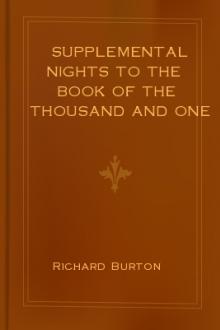Supplemental Nights to The Book of the Thousand and One Nights by Sir Richard Francis Burton (acx book reading txt) 📕

- Author: Sir Richard Francis Burton
- Performer: -
Book online «Supplemental Nights to The Book of the Thousand and One Nights by Sir Richard Francis Burton (acx book reading txt) 📕». Author Sir Richard Francis Burton
[FN#367] It is not easy to make sense of this passage especially when the Wazir is spoken of.
[FN#368] This is a rechauff� of the Sandal-Wood Merchant and the Sharpers. Vol. vi. 202.
[FN#369] I have followed Mr. Payne’s adaptation of the text as he makes sense, whilst the Arabic does not. I suppose that the holes are disposed crosswise.
[FN#370] i.e. Thy skill is so great that thou wilt undermine my authority with the king.
[FN#371] This famous tale is first found in a small collection of Latin fables (Adolphi Fabul� apud Leyser Hist. Poet. Medii �vi, p. 200�8), beginning
C�cus erat quidam, cui pulcra virago, etc.
The date is 1315, and Caxton printed it in English in 1483; hence it was adopted by Boccaccio, Day vii., Novella 9; whence Chaucer’s “Marchaundes Tale”: this, by-the-by, was translated by Pope in his sixteenth or seventeenth year, and christened “January and May.” The same story is inserted in La Fontaine (Contes, lib. ii., No. 8), “La Gageure des trois Comm�res,” with the normal poirier; and lastly it appears in Wieland’s “Oberon,”
canto vi.; where the Fairy King restores the old husband’s sight, and Titania makes the lover on the pear-tree invisible. Mr.
Clouston refers me also to the Bah�r-i-D�nish, or Prime of Knowledge (Scott’s translation, vol. ii., pp. 64�68); “How the Brahman learned the Tirrea Bede”; to the Turkish “Kirk Wazir”
(Forty Wazirs) of the Shaykh-Zadeh (xxivth Wazir’s story); to the “Com�dia Lydi�,” and to Barbazan’s “Fabliaux et Contes” t. iii.
p. 451, “La Saineresse,” the cupping-woman.
[FN#372] In the European versions it is always a pear-tree.
[FN#373] This supernatural agency, ever at hand and ever credible to Easterns, makes this the most satisfactory version of the world-wide tale.
[FN#374] i.e. till next harvest time.
[FN#375] The “‘Ashsh�r,” or Tither, is most unpopular in the Nile-valley as in Wales; and he generally merits his ill-repute.
Tales concerning the villainy of these extortioners abound in Egypt and Syria. The first step in improvement will be so to regulate the tithes that the peasants may not be at the mercy of these “publicans and sinners” who, however, can plead that they have paid highly for appointment to office and must recoup themselves.
[FN#376] Arab. “‘Ammir”=cause to flourish.
[FN#377] Arab. “Afkah,” a better Fak�h or theologian; all Moslem law being based upon the Koran, the Sayings (Hadis) and Doings (Sunnat) of the Prophet; and, lastly, the Rasm or immemorial custom of the country provided that it be not opposed to the other three.
[FN#378] If the number represent the days in the Moslem year it should be 354=6 months of 29 days and the rest of 30).
[FN#379] The affirmative particle “kad” preceding a verb in the past gives it a present and at times a future signification.
[FN#380] A danik, the Persian “D�ng,” is one-sixth of a dirham, i.e. about one penny. See vol. ii. 204.
[FN#381] It would mightily tickle an Eastern audience to hear of a Tither being unable to do any possible amount of villainy.
[FN#382] i.e. The oath of triple divorce which is, I have said, irrevocable, and the divorc�e may not be taken again by her husband till her marriage with another man (the Mustahill of The Nights) has been consummated. See vol. iv., 48.
[FN#383] i.e. thousandfold cuckold.
[FN#384] Arab. “Wad�‘ah”=the blows which the Robber had given him.
[FN#385] Arab. “Sindiy�n” (from the Persian) gen. used for the holm-oak, the Quercus pseudococcifera, vulgarly termed ilex, or native oak, and forming an extensive scrub in Syria, For this and other varieties of Quercus, as the Mall�l and the Ball�t, see Unexplored Syria, i. 68.
[FN#386] Hibernic�
[FN#387] Lit. “In the way of moderation”=at least, at the most moderate reckoning.
[FN#388] Arab. “Rasm�l,” the vulg. Syrian and Egyptian form of Raas al-m�l=stockin-trade.
[FN#389] Usually a ring or something from his person to show that all was fair play; here however, it was a watchword.
[FN#390] Arab. “Ya Mady�bah,” prob. a clerical error for “Mady�nah,” alluding to her many debts which he had paid. Here, however, I suspect the truly Egyptian term “Y� Many�kah!”=O thou berogered; a delicate term of depreciation which may be heard a dozen times a day in the streets of Cairo. It has also a masculine form, “Y� Many�k!”
[FN#391] About=100 lb. Mr. Sayce (Comparative Philol. p. 210) owns that Mn is old Egyptian but makes it a loan from the “Semites,” like S�s (horse), Sar (prince), Sepet (lip) and Murcabutha (chariot), and goes to its origin in the Acratan column, because “it is not found before the times when the Egyptians borrowed freely from Palestine.” But surely it is premature to draw such conclusion when we have so much still to learn concerning the dates of words in Egyptian.
[FN#392] Arab. J�mi’. This anachronism, like many of the same kind, is only apparent. The faith preached by Sayyidn� Is� was the Islam of his day and dispensation, and it abrogated all other faiths till itself abrogated by the mission of Mahommed. It is therefore logical to apply to it terms which we should hold to be purely Moslem. On the other hand it is not logical to paint the drop-curtain of the Ober-Ammergau “Miracle-play” with the Mosque of Omar and the minarets of AlIslam. I humbly represented this fact to the mechanicals of the village whose performance brings them in so large a sum every decade; but Snug, Snout and Bottom turned up the nose of contempt and looked upon me as a mere “shallow sceptic.”
[FN#393] Arab. “Tal�mizah,” plur. of Tilm�z, a disciple, a young attendant. The word is Syriac <Arabic letters> and there is a Heb. root <Hebrew letters> but no Arabic. In the Durrat al-Ghaww�s, however, Tilm�z, Bilk�s, and similar words are Arabic in the form of Fa’l�l and Fi’l�l
[FN#394] R�h Allah, lit.=breath of Allah, attending to the miraculous conception according to the Moslems. See vol. v. 238.
[FN#395] Readers will kindly pronounce this word “Sahr�” not Sah�r�.
[FN#396] Mr. Clouston refers for analogies to this tale to his “Oriental Sources of some of Chaucer’s Tales” (Notes and Queries, 1885�86), and he finds the original of The Pardoner’s Tale in one of the J�takas or Buddhist Birth-stories entitled Vedabbha Jataka. The story is spread over all Europe; in the Cento Novelle Antiche; Morlini; Hans Sachs, etc. And there are many Eastern versions, e.g. a Persian by Far�d al-D�n “‘Attar” who died at a great age in A.D. 1278; an Arabic version in The Orientalist (Kandy, 1884); a Tibetan in Rollston’s Tibetan Tales; a Cashmirian in Knowles’ Dict. of Kashm�r� Proverbs, etc., etc., etc.
[FN#397] Arab. “‘Aw�n” lit.=aids, helpers; the “Aun of the Jinn”
has often occurred.
[FN#398] i.e. the peasant.
[FN#399] i.e. those serving on the usual feudal tenure; and bound to suit and service for their fiefs.
[FN#400] i.e. the yearly value of his fief.
[FN#401] i.e. men who paid taxes.
[FN#402] Arab. “Ras�t�k” plur. of Rust�k. See vol. vi. 289.
[FN#403] This adventure is a rechauff� of Amjad’s adventure (vol. iii. 333) without, however, its tragic catastrophe.
[FN#404] The text is so concise as to be enigmatical. The house was finely furnished for a feast, as it belonged to the Man who was lavish, etc.
[FN#405] Arab. “Khubz Sam�z;” the latter is the Arabisation of the Pers. Sam�d, fine white bread, simnel, Germ. semmel.
[FN#406] The text has “Bak�l�t”=pot-herbs; but it is probably a clerical error for “Bakl�w�t.” See vol. ii. 311.
[FN#407] Egyptian-like he at once calls upon Allah to witness a lie and his excuse would be that the lie was well-intentioned.
[FN#408] i.e. The private bagnio which in old days every grand house possessed.
[FN#409] This is a fancy title, but it suits the tale better than that in the text (xi. 183) “The Richard who lost his wealth and his wits.” Mr. Clouston refers to similar stories in Sacchetti and other early Italian novelists.
[FN#410] Arab. “Al-Muwaswis”: for “Wisw�s” see vol. i. 106. This class of men in stories takes the place of our “cunning idiot,”
and is often confounded with the Saud�wi, the melancholist proper.
[FN#411] Arab. “Hamhama,” an onomapoeic, like our hum, hem, and haw.
[FN#412] Arab. “Barniyah,” a vessel either of glass or pottery like that in which the manna was collected (Exod. xvi. 33).
[FN#413] A hasty man, as Ghazb�n=an angry man.
[FN#414] The Bresl. Edit. misprint. “Khablas” in more places than one, now with a S�n, then with a S�d. Khalbas suggests “Khalb�s,” a buffoon, for which see vol. ii. 143. In Egypt, however, the latter generally ends in a Sad (see Lane’s “Khalboos,” M. E. chap. xxvii).
[FN#415] This story is a rechauff� of the Jewish Kazi and his pious wife; see vol. v. 256.
[FN#416] The Arab form of “Naysh�p�r”=reeds of (King) Shap�r: see vol. ix. 230.
[FN#417] Arab. “Al� Tar�k al-Satr wa al-Sal�mah,” meaning that each other’s wives did not veil before their brothers-in-law as is usually done. It may also mean that they were under Allah’s protection and in best of condition.
[FN#418] i.e. he dared not rape her.
[FN#419] i.e. her “yes” meant “yes” and her “no” meant “no.”
[FN#420] “Ignorance” (Jahl) may, here and elsewhere, mean wickedness, forwardness, folly, vicious folly or uncalled-for wrath. Here Arabic teaches a good lesson, for ignorance, intemperance and egoism are, I repeat, the roots of all evil.
[FN#421] So Mohammed said of a child born in adultery “The babe to the blanket (i.e. let it be nursed and reared) and the adultress to the stone.”
[FN#422] Arab. “Wa h�,” etc., an interjection corresponding with the Syriac “ho” lo! (i.e., look) behold! etc.
[FN#423] This paragraph is supplied by Mr. Payne: something of the kind has evidently fallen out of the Arab text.
[FN#424] i.e. in the presence of witnesses, legally.
[FN#425] Lit. a myriad, ten thousand dirhams. See vol. iv. 281.
[FN#426] The fire was intended to defend the mother and babe from Jinns, bad spirits, the evil eye, etc. Romans lit candles in the room of the puerpara; hence the goddess Candelifera, and the term Candelaria applied to the B.V. In Brand’s Popular Antiquities (ii. 144) we find, “Gregory mentions an ordinary superstition of the old wives who dare not trust a child in a cradle by itself alone without a candle;” this was for fear of the “night-hag” (Milton, P. L., ii. 662). The same idea prevailed in Scotland and in Germany: see the learned Liebrecht (who translated the Pentamerone) “Zur Folkskunde,” p. 31. In Sweden if the candle go out, the child may be carried off by the Trolls (Weckenstedt, Wendische Sagen, p. 446). The custom has been traced to the Malay peninsula, whither it was probably imported by the Hindus or the Moslems, and amongst the Tajiks in Bokhara.
For the Hindu practice, see Katha S. S. 305, and Prof. Tawney’s learned note analysed above.
[FN#427] Arab. “K�hinah,” fem. of K�hin (Cohen): see Kah�nah, vol. i. 28.
[FN#428] i.e. for a long time, as has been before explained.
[FN#429] i.e. at his service. Arabia was well provided with Hetair� and public women long before the days of AlIslam.
[FN#430] Arab. “Athar”=sign, mark, trail.
[FN#431] i.e. Persia. See vol. v. 26.
[FN#432] Arab. “‘Ak�k�r” plur. of ‘Akk�r prop.=aromatic roots; but applied





Comments (0)